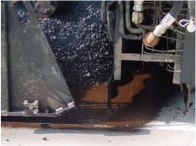 What: A heavy application of polymer modified asphalt emulsion followed by an ultrathin (1/2-1”) gap-graded hot mix asphalt layer, both applied by a single machine. The emulsion application rate is 0.13 to 0.30 gal/yd2. The mat is rolled just enough to seat the aggregate into the emulsion which foams up when the hot mix is placed over it, resulting in a superior bond to the existing pavement. Ultrathin bonded wearing course is a high-performance surface course for preventive maintenance or new construction. It is used over both asphalt and concrete pavements.
What: A heavy application of polymer modified asphalt emulsion followed by an ultrathin (1/2-1”) gap-graded hot mix asphalt layer, both applied by a single machine. The emulsion application rate is 0.13 to 0.30 gal/yd2. The mat is rolled just enough to seat the aggregate into the emulsion which foams up when the hot mix is placed over it, resulting in a superior bond to the existing pavement. Ultrathin bonded wearing course is a high-performance surface course for preventive maintenance or new construction. It is used over both asphalt and concrete pavements.
Where: Bonded ultrathin overlays are appropriate on structurally sound concrete or asphalt pavements with low to medium severity surface distresses such as rutting (less than ½”), bleeding, raveling, polished aggregates, friction loss, spalling of longitudinal and transverse joints and corner breaks. Before construction, patches or potholes should be repaired, and transverse, longitudinal, block, edge or reflective cracking should be properly sealed. Map cracking and scaling should not exceed 10 yd2 in any 100 yd2 area, “D” cracking should not exceed low severity, blowups should not be present, water bleeding and pumping should not be present and faulting of transverse joints and cracks should not exceed 3/8 inch. Bonded ultrathin overlays are an effective pavement preservation treatment for very high volume roadways where quick traffic return is important. It has been successfully used on many types of pavements including airports, residential streets, city streets and interstates. It is also used as a high performance surface over new construction.
 Why (advantages): The superior bonding resists the raveling and delamination common to very thin open HMA overlays. The treatment protects pavement structure, seals out water and preserves both asphalt and concrete pavements. The black surface has the same appearance as new hot mix asphalt construction. High quality aggregates give lasting skid resistance. The quick construction, night construction and quick traffic return (within 10 minutes) reduce user delays. The ultrathin lift retains clearances under overpasses. The open surface reduces noise, especially over concrete. It also reduces back spray in wet weather and improves visibility and safety. Bonded ultrathin overlays are one of the most long lasting pavement preservation treatments.
Why (advantages): The superior bonding resists the raveling and delamination common to very thin open HMA overlays. The treatment protects pavement structure, seals out water and preserves both asphalt and concrete pavements. The black surface has the same appearance as new hot mix asphalt construction. High quality aggregates give lasting skid resistance. The quick construction, night construction and quick traffic return (within 10 minutes) reduce user delays. The ultrathin lift retains clearances under overpasses. The open surface reduces noise, especially over concrete. It also reduces back spray in wet weather and improves visibility and safety. Bonded ultrathin overlays are one of the most long lasting pavement preservation treatments.
Why not (disadvantages): Bonded ultrathin overlays are more expensive than other preventive maintenance treatments such as micro surfacing, slurry seals and chip seals. Reflective cracks may need periodic sealing.
When: Bonded ultrathin overlays should be applied when the pavement structure is in good condition, but there are minor to moderate surface distresses. It may also be applied to lessen road/tire noise and improve friction, especially on concrete pavements. And it may be placed as a high performance surface over new construction.
Estimated life extension: 8-15 years over pavements in good condition; 5-10 years on pavements in fair condition; 2-10 years for pavements in poor condition.
For information on hot mix overlays, consult the Thin Hot Mix Overlay Checklist put together by the Foundation and FHWA.
